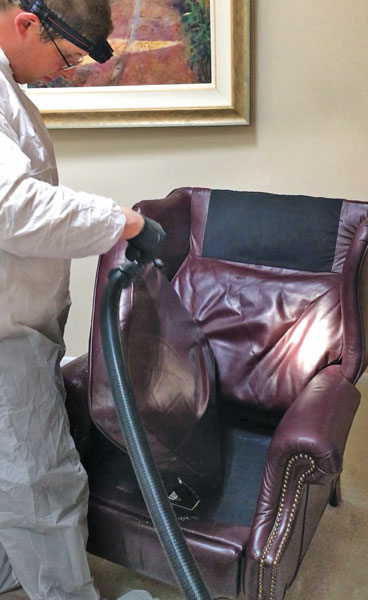“An investment in knowledge always pays the best interest.”
— Benjamin Franklin

Step-by-step photos like this one help convey expectations. PHOTO: PETE SCHOPEN
Without question, the most important asset to a business is a capable workforce. I witnessed this firsthand at Rose Pest Solutions’ annual conference in Troy, Mich., earlier this year. I gave a presentation on fleas to approximately 400 people. For three days, the owners and operators of Rose wined, dined and housed their employees at a beautiful hotel outside of Detroit. The management gushed to me about their employees, and the staff clearly felt important during the event.
What impressed me the most, though, was the knowledge of the employees. From the experienced bed bug dog handlers to the rookie techs, they all knew pest control.
That is what I’ve always wanted at Schopen Pest Solutions. I want my employees to be able to go to a workshop and be among the smartest people in the room. I want my billing specialist to sell a German cockroach job as efficiently as one of my seasoned technicians. Nothing gives a person more confidence than knowing, inside and out, about a subject. It is much easier to sell and service for odorous house ants if you know that they are monomorphic vs. asking your clients, “Are you seeing itty-bitty ants, or great big ones?”
MAKE IT OFFICIAL
I’ve discussed Schopen Pest Solutions’ training methods before, but this past winter I actually committed them to paper. I think a top-notch training manual is the best way to transfer to the techs and staff the ideas of the owner or operations manager.
Your company training manual is your voice. It’s your identity. My training guide is designed to help my employees treat homes the way Pete Schopen wants them treated.
I was lucky enough a few years ago to read Evanston, Ill.-based Smithereen Pest Management Services’ training manual. Anyone could read that manual and come away with a good grasp on pest control. I talked to Jim Anderson, who compiled the manual before his retirement as corporate trainer there. He told me case studies were an incredibly important component, as real-life situations stick with trainees. He also told me it’s important to have the Golden Rule — “Treat others the way that you would want to be treated” — as a mantra when training.
Keep in mind, I have always trained my techs. But as my company has grown, I’m not able to go out on ride alongs anymore. Because I’m trusting other people to train my new employees, I knew we needed a uniform, consistent manner in which to train them. Thus, the Schopen Pest Solutions Training Manual was developed.
TRAINING DAYS
The first thing I had to decide was how to organize the manual. I chose to go day-by-day:
- Day One is about proper attire and hygiene while on the job. Tools, personal protective equipment (PPE) and customer service also are reviewed. Photographs illustrate the proper way to use their tools, and what is allowable for facial hair.
- Day Two is dedicated to chemicals we use by category (dusts, aerosols, baits, and so on).
- Day Three covers paperwork such as graphs, service agreements, receipts, etc.
During training, the new employee will ride along with a veteran tech. In the future, I want to hire a training director to fill this role.
Each day, the tech also has homework. For example, at the end of Day One, new techs must read the first chapter of the Truman’s Scientific Guide to Pest Management Operations (Available at the PMP Bookstore). Day Two, they must read the label for our go-to rodenticide. Day Three, they must read all of our service agreements for ants, cockroaches, mice, and other pests.
At the end of the first week, they take a test. After taking their test, they meet with our human resources specialist to go over our Employee Handbook. Topics include sexual harassment, ladder safety and absenteeism.
During the second week, the techs learn about rodents, avoiding accidents in homes, parking at clients’ houses, customer relations, key performance indicators, and how to file paperwork. On Friday, they have more classroom time with me (or the training director,) going over items such as door sweeps and working with a programmer, and then they take another test.
The third week involves more on-the-job training — mixed in with driving safety, upselling and a focus on stink bugs and bed bugs.
The fourth week breaks down our early-bird wasp program, carpenter ant treatments and flea jobs.
At the end of four weeks, our new techs take a harder test to check their knowledge of the job. If they pass, they get a route, starting on the Monday of the fifth week.
The training manual and how to implement it is brand-new for us; it is a work in progress. When 2020 started, my training manual was only 24 pages long. Now it is more than 30 pages, and growing! We did a poor job of using the training manual once COVID-19 hit, so our new batch of techs were only given a small amount of training from the guide. I’m hoping that by spring 2021, however, we will be relying heavily on the Schopen Training Manual for all of our training.
Schopen is owner and founder of Schopen Pest Solutions, McHenry, Ill. You can email him at pete@schopenpest.com or reach him via Twitter: @schopenpest; Instagram: @peteschopen; or Facebook: Schopen Pest Solutions, Inc.
Leave A Comment